Investigating the Reliability of Stationary Design Rainfall in a Mediterranean Region under a Changing Climate
Abstract
:1. Introduction
2. Materials and Methods
2.1. Study Area
2.2. SIAS Rainfall Dataset and Regional DDFs
2.3. Methodology
2.3.1. Regional Quantile Exceedance Detection
2.3.2. Quantile Comparison and Revision of the Return Periods
3. Results and Discussion
3.1. Regional Quantile Exceedance
3.2. Revision of the Return Periods Defined with the Regional Approach
4. Conclusions
Author Contributions
Funding
Data Availability Statement
Conflicts of Interest
References
- Kumar, N.; Poonia, V.; Gupta, B.B.; Goyal, M.K. A Novel Framework for Risk Assessment and Resilience of Critical Infrastructure towards Climate Change. Technol. Forecast. Soc. Chang. 2021, 165, 120532. [Google Scholar] [CrossRef]
- Debortoli, N.S.; Camarinha, P.I.M.; Marengo, J.A.; Rodrigues, R.R. An Index of Brazil’s Vulnerability to Expected Increases in Natural Flash Flooding and Landslide Disasters in the Context of Climate Change. Nat. Hazards 2017, 86, 557–582. [Google Scholar] [CrossRef]
- Montrasio, L.; Valentino, R.; Losi, G.L. Towards a Real-Time Susceptibility Assessment of Rainfall-Induced Shallow Landslides on a Regional Scale. Nat. Hazards Earth Syst. Sci. 2011, 11, 1927–1947. [Google Scholar] [CrossRef] [Green Version]
- Zellou, B.; Rahali, H. Assessment of the Joint Impact of Extreme Rainfall and Storm Surge on the Risk of Flooding in a Coastal Area. J. Hydrol. 2019, 569, 647–665. [Google Scholar] [CrossRef]
- Cheng, L.; AghaKouchak, A. Nonstationary Precipitation Intensity-Duration-Frequency Curves for Infrastructure Design in a Changing Climate. Sci. Rep. 2014, 4, 7093. [Google Scholar] [CrossRef] [PubMed] [Green Version]
- Andimuthu, R.; Kandasamy, P.; Mudgal, B.V.; Jeganathan, A.; Balu, A.; Sankar, G. Performance of Urban Storm Drainage Network under Changing Climate Scenarios: Flood Mitigation in Indian Coastal City. Sci. Rep. 2019, 9, 7783. [Google Scholar] [CrossRef] [Green Version]
- Yu, J.; Qin, X.; Chiew, Y.M.; Min, R.; Shen, X. Stochastic Optimization Model for Supporting Urban Drainage Design under Complexity. J. Water Resour. Plann. Manag. 2017, 143, 05017008. [Google Scholar] [CrossRef]
- Scala, P.; Cipolla, G.; Treppiedi, D.; Noto, L.V. The Use of GAMLSS Framework for a Non-Stationary Frequency Analysis of Annual Runoff Data over a Mediterranean Area. Water 2022, 14, 2848. [Google Scholar] [CrossRef]
- Madsen, H.; Arnbjerg-Nielsen, K.; Mikkelsen, P.S. Update of Regional Intensity–Duration–Frequency Curves in Denmark: Tendency towards Increased Storm Intensities. Atmos. Res. 2009, 92, 343–349. [Google Scholar] [CrossRef]
- Borga, M.; Vezzani, C.; Fontana, G.D. Regional Rainfall Depth–Duration–Frequency Equations for an Alpine Region. Nat. Hazards 2005, 36, 221–235. [Google Scholar] [CrossRef]
- Forestieri, A.; Lo Conti, F.; Blenkinsop, S.; Cannarozzo, M.; Fowler, H.J.; Noto, L.V. Regional Frequency Analysis of Extreme Rainfall in Sicily (Italy): Regional Frequency Analysis of Extreme Rainfall, Sicily (Italy). Int. J. Clim. 2018, 38, e698–e716. [Google Scholar] [CrossRef]
- Kourtis, I.M.; Tsihrintzis, V.A. Adaptation of Urban Drainage Networks to Climate Change: A Review. Sci. Total. Environ. 2021, 771, 145431. [Google Scholar] [CrossRef]
- Kourtis, I.M.; Tsihrintzis, V.A. Update of Intensity-Duration-Frequency (IDF) Curves under Climate Change: A Review. Water Supply 2022, 22, 4951–4974. [Google Scholar] [CrossRef]
- Cook, L.M.; McGinnis, S.; Samaras, C. The Effect of Modeling Choices on Updating Intensity-Duration-Frequency Curves and Stormwater Infrastructure Designs for Climate Change. Clim. Chang. 2020, 159, 289–308. [Google Scholar] [CrossRef] [Green Version]
- Cipolla, G.; Francipane, A.; Noto, L.V. Classification of Extreme Rainfall for a Mediterranean Region by Means of Atmospheric Circulation Patterns and Reanalysis Data. Water Resour. Manag. 2020, 34, 3219–3235. [Google Scholar] [CrossRef]
- Myhre, G.; Alterskjær, K.; Stjern, C.W.; Hodnebrog, Ø.; Marelle, L.; Samset, B.H.; Sillmann, J.; Schaller, N.; Fischer, E.; Schulz, M.; et al. Frequency of Extreme Precipitation Increases Extensively with Event Rareness under Global Warming. Sci. Rep. 2019, 9, 16063. [Google Scholar] [CrossRef] [Green Version]
- Nissen, K.M.; Ulbrich, U. Increasing Frequencies and Changing Characteristics of Heavy Precipitation Events Threatening Infrastructure in Europe under Climate Change. Nat. Hazards Earth Syst. Sci. 2017, 17, 1177–1190. [Google Scholar] [CrossRef] [Green Version]
- Noto, L.V.; Cipolla, G.; Francipane, A.; Pumo, D. Climate Change in the Mediterranean Basin (Part I): Induced Alterations on Climate Forcings and Hydrological Processes. Water Resour. Manag. 2022, 37, 2287–2305. [Google Scholar] [CrossRef]
- Noto, L.V.; Cipolla, G.; Pumo, D.; Francipane, A. Climate Change in the Mediterranean Basin (Part II): A Review of Challenges and Uncertainties in Climate Change Modeling and Impact Analyses. Water Resour. Manag. 2023, 37, 2307–2323. [Google Scholar] [CrossRef]
- Lionello, P.; Gacic, M.; Gomis, D.; Garcia-Herrera, R.; Giorgi, F.; Planton, S.; Trigo, R.; Theocharis, A.; Tsimplis, M.N.; Ulbrich, U.; et al. Program Focuses on Climate of the Mediterranean Region. Eos Trans. AGU 2012, 93, 105–106. [Google Scholar] [CrossRef]
- Ali, E.; Cramer, W.; Carnicer, J.; Georgopoulou, E.; Hilmi, N.J.M.; Le Cozannet, G.; Lionello, P. Cross-Chapter Paper 4: Mediterranean Region. In Climate Change 2022: Impacts, Adaptation and Vulnerability; Contribution of Working Group II to the Sixth Assessment Report of the Intergovernmental Panel on Climate Change; Intergovernmental Panel on Climate Change: Geneva, Switzerland, 2022. [Google Scholar]
- Twardosz, R.; Walanus, A.; Guzik, I. Warming in Europe: Recent Trends in Annual and Seasonal Temperatures. Pure Appl. Geophys. 2021, 178, 4021–4032. [Google Scholar] [CrossRef]
- Hatzianastassiou, N.; Papadimas, C.D.; Lolis, C.J.; Bartzokas, A.; Levizzani, V.; Pnevmatikos, J.D.; Katsoulis, B.D. Spatial and Temporal Variability of Precipitation over the Mediterranean Basin Based on 32-Year Satellite Global Precipitation Climatology Project Data, Part I: Evaluation and Climatological Patterns: Satellite Mediterranean Precipitation Climatology. Int. J. Climatol. 2016, 36, 4741–4754. [Google Scholar] [CrossRef]
- Achite, M.; Caloiero, T.; Wałęga, A.; Krakauer, N.; Hartani, T. Analysis of the Spatiotemporal Annual Rainfall Variability in the Wadi Cheliff Basin (Algeria) over the Period 1970 to 2018. Water 2021, 13, 1477. [Google Scholar] [CrossRef]
- Varouchakis, E.A.; Corzo, G.A.; Karatzas, G.P.; Kotsopoulou, A. Spatio-Temporal Analysis of Annual Rainfall in Crete, Greece. Acta Geophys. 2018, 66, 319–328. [Google Scholar] [CrossRef]
- Treppiedi, D.; Cipolla, G.; Francipane, A.; Noto, L.V. Detecting Precipitation Trend Using a Multiscale Approach Based on Quantile Regression over a Mediterranean Area. Int. J. Clim. 2021, 41, 5938–5955. [Google Scholar] [CrossRef]
- Blanchet, J.; Molinié, G.; Touati, J. Spatial Analysis of Trend in Extreme Daily Rainfall in Southern France. Clim. Dyn. 2018, 51, 799–812. [Google Scholar] [CrossRef]
- Sottile, G.; Francipane, A.; Adelfio, G.; Noto, L.V. A PCA-Based Clustering Algorithm for the Identification of Stratiform and Convective Precipitation at the Event Scale: An Application to the Sub-Hourly Precipitation of Sicily, Italy. Stoch. Env. Res. Risk Assess. 2022, 36, 2303–2317. [Google Scholar] [CrossRef]
- Arnone, E.; Pumo, D.; Viola, F.; Noto, L.V.; La Loggia, G. Rainfall Statistics Changes in Sicily. Hydrol. Earth Syst. Sci. 2013, 17, 2449–2458. [Google Scholar] [CrossRef] [Green Version]
- Di Piazza, A.; Conti, F.L.; Noto, L.V.; Viola, F.; La Loggia, G. Comparative Analysis of Different Techniques for Spatial Interpolation of Rainfall Data to Create a Serially Complete Monthly Time Series of Precipitation for Sicily, Italy. Int. J. Appl. Earth Obs. Geoinf. 2011, 13, 396–408. [Google Scholar] [CrossRef]
- Treppiedi, D.; Cipolla, G.; Noto, L.V. Convective Precipitation over a Mediterranean Area: From Identification to Trend Analysis Starting from High-resolution Rain Gauges Data. Int. J. Climatol. 2023, 43, 293–313. [Google Scholar] [CrossRef]
- Feloni, E.G.; Baltas, E.A.; Nastos, P.T.; Matsangouras, I.T. Implementation and Evaluation of a Convective/Stratiform Precipitation Scheme in Attica Region, Greece. Atmos. Res. 2019, 220, 109–119. [Google Scholar] [CrossRef]
- Westra, S.; Fowler, H.J.; Evans, J.P.; Alexander, L.V.; Berg, P.; Johnson, F.; Kendon, E.J.; Lenderink, G.; Roberts, N.M. Future Changes to the Intensity and Frequency of Short-Duration Extreme Rainfall. Rev. Geophys. 2014, 52, 522–555. [Google Scholar] [CrossRef] [Green Version]
- Harris, R.I. Gumbel Re-Visited—A New Look at Extreme Value Statistics Applied to Wind Speeds. J. Wind. Eng. Ind. Aerodyn. 1996, 59, 1–22. [Google Scholar] [CrossRef]
- Massey, F.J. The Kolmogorov-Smirnov Test for Goodness of Fit. J. Am. Stat. Assoc. 1951, 46, 68–78. [Google Scholar] [CrossRef]
- Pumo, D.; Carlino, G.; Blenkinsop, S.; Arnone, E.; Fowler, H.; Noto, L.V. Sensitivity of Extreme Rainfall to Temperature in Semi-Arid Mediterranean Regions. Atmos. Res. 2019, 225, 30–44. [Google Scholar] [CrossRef]
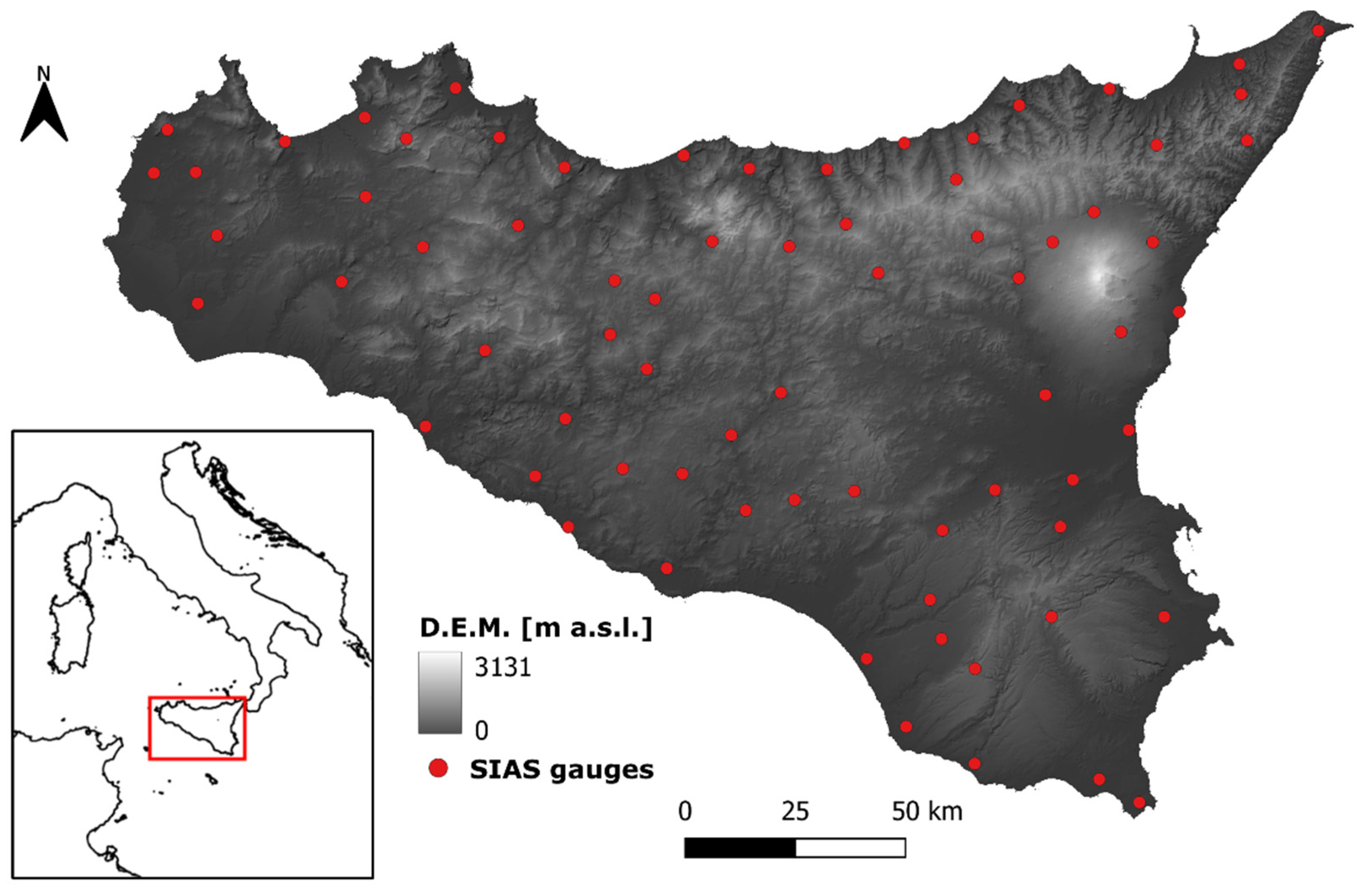
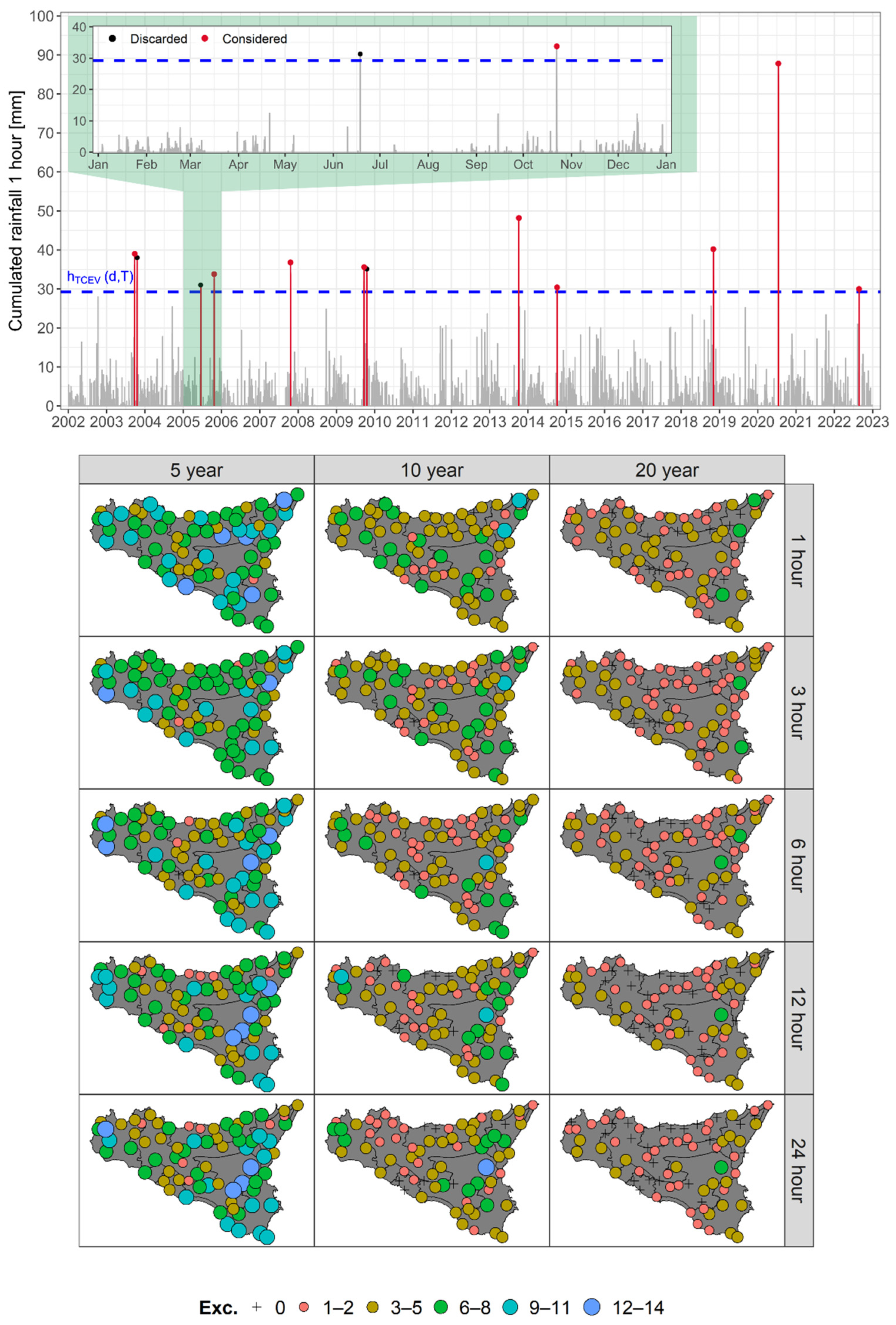
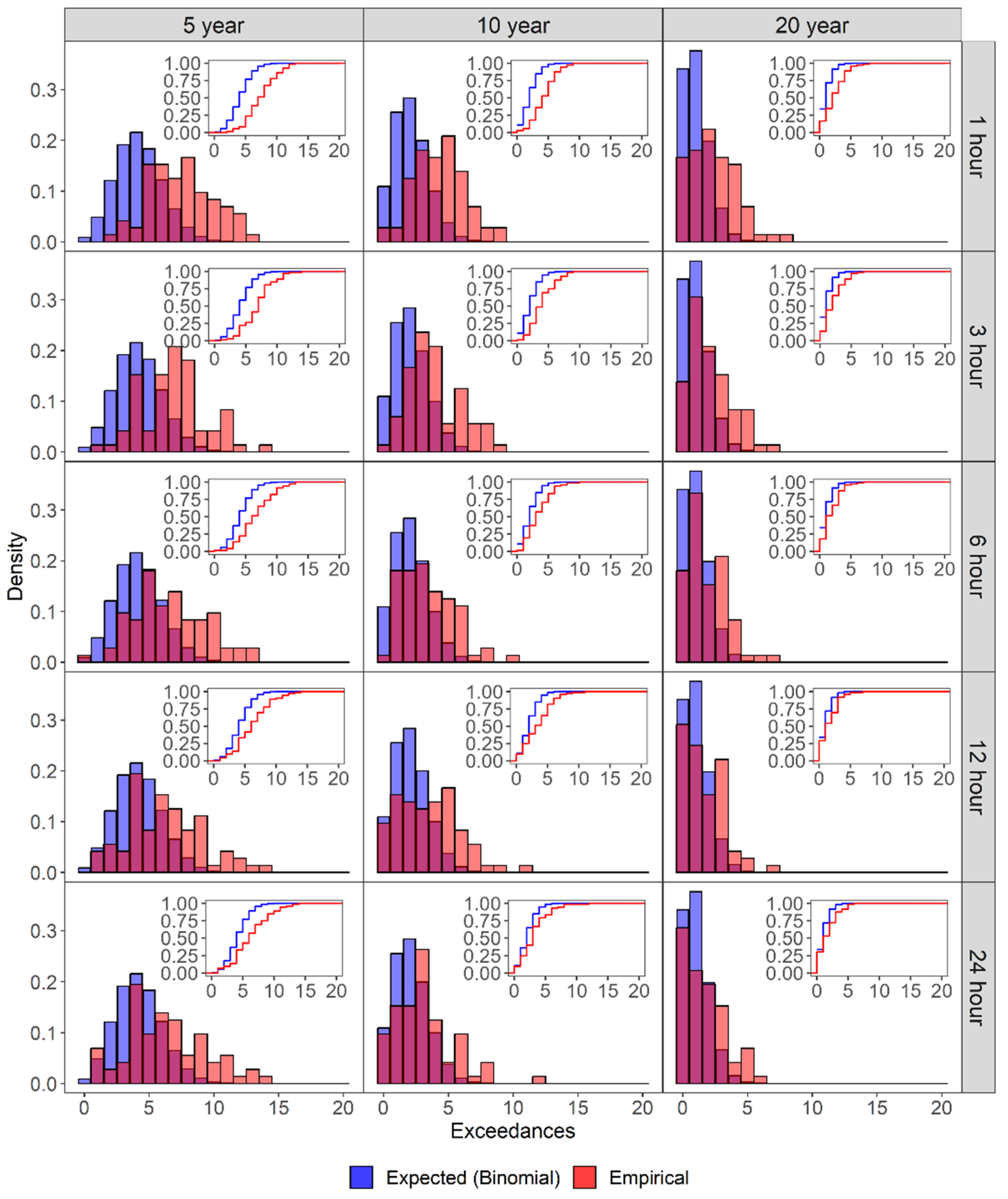

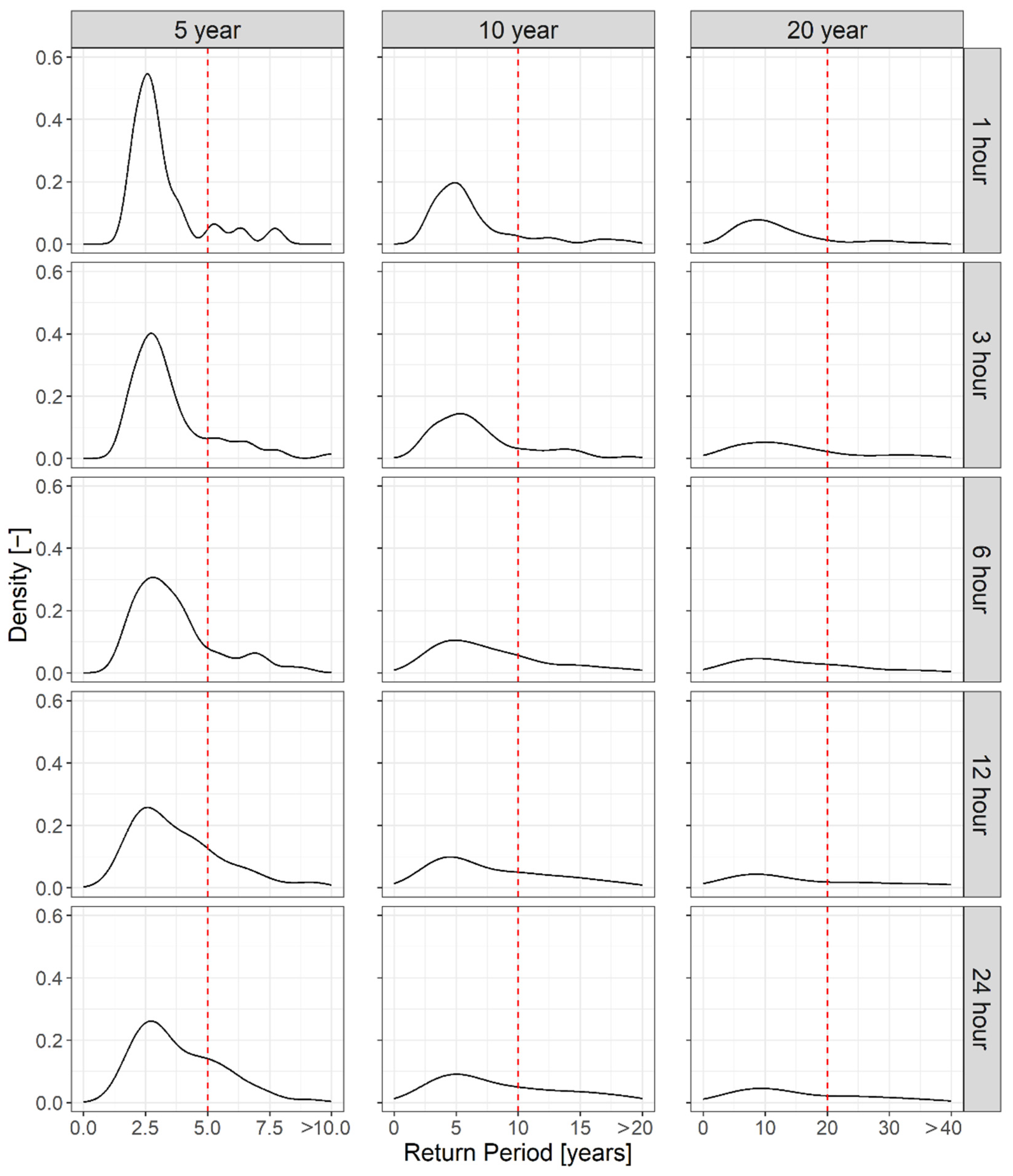
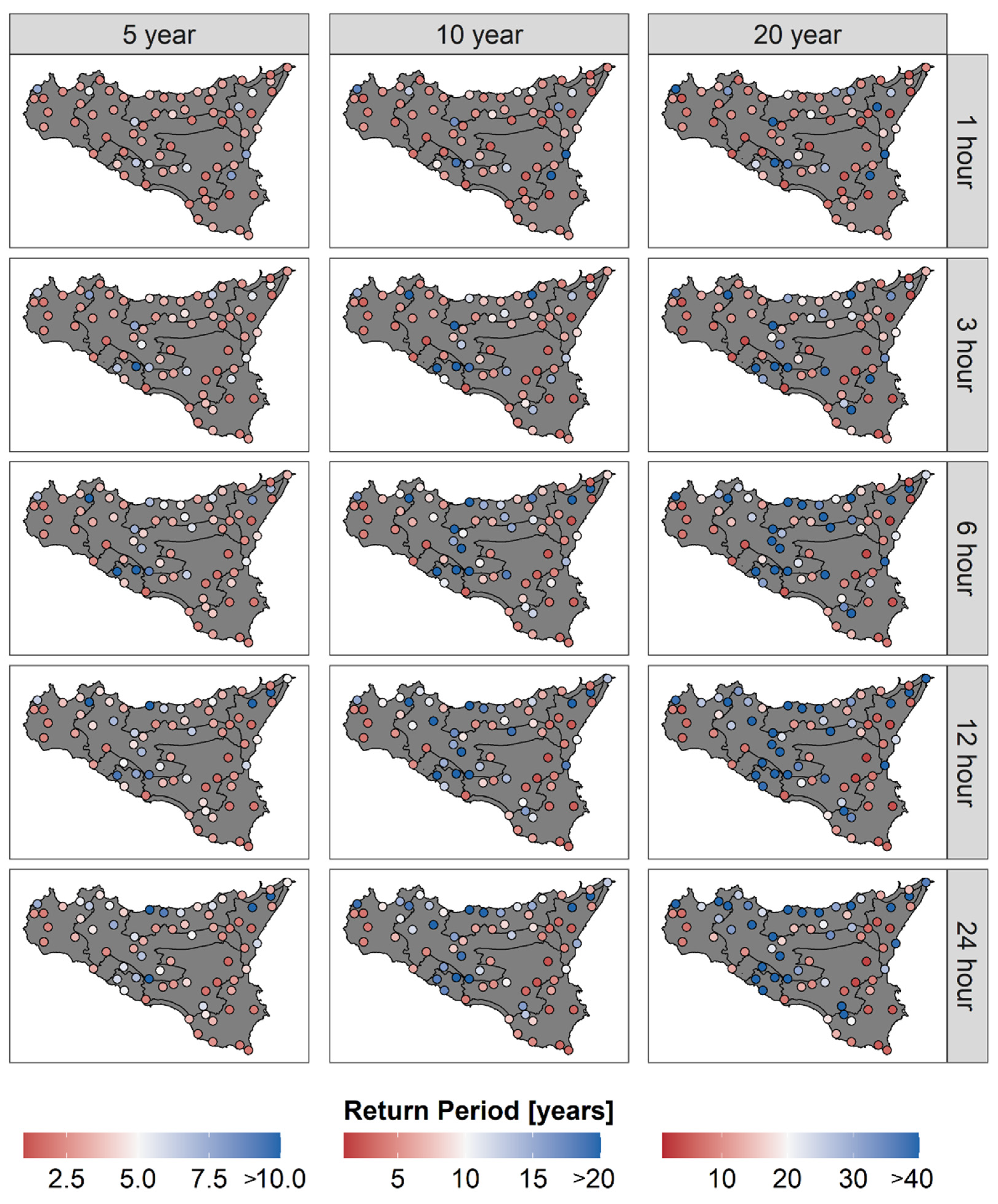
Disclaimer/Publisher’s Note: The statements, opinions and data contained in all publications are solely those of the individual author(s) and contributor(s) and not of MDPI and/or the editor(s). MDPI and/or the editor(s) disclaim responsibility for any injury to people or property resulting from any ideas, methods, instructions or products referred to in the content. |
© 2023 by the authors. Licensee MDPI, Basel, Switzerland. This article is an open access article distributed under the terms and conditions of the Creative Commons Attribution (CC BY) license (https://creativecommons.org/licenses/by/4.0/).
Share and Cite
Treppiedi, D.; Cipolla, G.; Francipane, A.; Cannarozzo, M.; Noto, L.V. Investigating the Reliability of Stationary Design Rainfall in a Mediterranean Region under a Changing Climate. Water 2023, 15, 2245. https://doi.org/10.3390/w15122245
Treppiedi D, Cipolla G, Francipane A, Cannarozzo M, Noto LV. Investigating the Reliability of Stationary Design Rainfall in a Mediterranean Region under a Changing Climate. Water. 2023; 15(12):2245. https://doi.org/10.3390/w15122245
Chicago/Turabian StyleTreppiedi, Dario, Giuseppe Cipolla, Antonio Francipane, Marcella Cannarozzo, and Leonardo Valerio Noto. 2023. "Investigating the Reliability of Stationary Design Rainfall in a Mediterranean Region under a Changing Climate" Water 15, no. 12: 2245. https://doi.org/10.3390/w15122245




